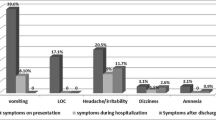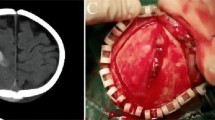Abstract
Purpose
The authors provide a comprehensive framework with which to approach paediatric calvarial injury sustained as a result of suspected abusive head trauma (AHT). This is achieved through the presentation of a case series set in the context of the unique morphology of the infant skull and the possible diagnostic pitfalls which may arise due to the presence of variant anatomy or other mimicking conditions.
Methods
A retrospective analysis of sixty-three patients referred to our institution with suspected AHT was carried out. Seventeen patients with skull fractures were identified and their fractures were described in terms of anatomical location, type and course. Our data was then interpreted in the light of known anatomical fracture mimics and the available literature on the subject.
Results
Forty-two skull fractures were identified and described in our cohort, most of which were simple linear fractures of the parietal bones (33%). There were also a substantial number of complex stellate fractures, namely of the parietal (29%) and occipital (10%) bones. Eleven fracture mimics including accessory sutures and wormian bones were also identified in this cohort.
Conclusions
Our study supports and builds on the existing literature, thereby offering a more complete view of the spectrum of calvarial damage sustained as a result of AHT in the context of its diagnostic pitfalls.



Similar content being viewed by others
Data availability
Data is available from the corresponding author upon reasonable request.
References
Kumar Choudhary A, Servaes S, Slovis TL et al (2018) Consensus statement on abusive head trauma in infants and young children. Pediatr Radiol 48:1048–1065. https://doi.org/10.1007/s00247-018-4149-1
Chevignard MP, Lind K (2014) Long-term outcome of abusive head trauma. Pediatr Radiol 44:S548–S558. https://doi.org/10.1007/s00247-014-3169-8
Jenny C, Hymel LCKP, Ritzen A et al (1999) Analysis of missed cases of abusive head trauma. JAMA 281:621–626. https://doi.org/10.1001/jama.281.7.621
Hettler J, Greenes DS (2003) Can the initial history predict whether a child with a head injury has been abused? Pediatrics 111:602–607. https://doi.org/10.1542/peds.111.3.602
Sidpra J, Abomeli D, Hameed B, Baker J, Mankad K (2020) Rise in the incidence of abusive head trauma during the COVID-19 pandemic. Arch Dis Child. https://doi.org/10.1136/archdischild-2020-319872, archdischild-2020-319872
Paddock M, Sprigg A, Offiah AC (2017) Imaging and reporting considerations for suspected physical abuse (non-accidental injury) in infants and young children. Part 2: axial skeleton and differential diagnoses. Clin Radiol 72:189–201. https://doi.org/10.1016/j.crad.2016.11.015
Mankad K, Chhabda S, Lim W, Oztekin O, Reddy N, Chong WK, Shroff M (2019) The neuroimaging mimics of abusive head trauma. Eur J Paediatr Neurol 23:19–30. https://doi.org/10.1016/j.ejpn.2018.11.006
Idriz S, Patel JH, Renani SA et al (2015) CT of normal developmental and variant anatomy of the pediatric skull: distinguishing trauma from normality 1. RadioGraphics 35:1585–1601. https://doi.org/10.1148/rg.2015140177
Society and College of Radiographers and The Royal College of Radiologists (2018) The radiological investigation of suspected physical abuse in children. https://www.rcr.ac.uk/system/files/publication/field_publication_files/bfcr174_suspected_physical_abuse.pdf. Accessed 8 Dec 2019
Christian CW, Committee on Child Abuse and Neglect (2015) Guidance for the clinician in rendering pediatric care the evaluation of suspected child physical abuse. Pediatrics 135:1337–1354. https://doi.org/10.1542/peds.2015-0356
Wiersema JM, Love JC, Derrick SM, Pinto DC, Donaruma-Kwoh M, Greeley CS (2014) Standardized descriptive method for the anthropological evaluation of pediatric skull fractures. J Forensic Sci 59:1487–1492. https://doi.org/10.1111/1556-4029.12532
Nayak SR, Krishnamurthy A, Madhan Kumar SJ, Prabhu LV, Jiji PJ, Pai MM, Kumar A, Avadhani R (2007) The mendosal suture of the occipital bone: occurrence in Indian population, embryology and clinical significance. Surg Radiol Anat 29:329–332. https://doi.org/10.1007/s00276-007-0216-2
Patel MD, Swinford AE, Filly RA (1994) Anatomic and sonographic features of the fetal skull. J Ultrasound Med 13:251–257. https://doi.org/10.7863/jum.1994.13.4.251
Hahn YS, Raimondi AJ, Mclone DG, Yamanouchi Y (1983) Traumatic mechanisms of head injury in child abuse. Childs Brain 10:229–241. https://doi.org/10.1159/issn.1016-2291
Merten DF, Osborne DRS, Radkowski MA, Leonidas JC (1984) Pediatric radiology craniocerebral trauma in the child abuse syndrome: radiological observations. Pediatr Radiol 14:272–277. https://doi.org/10.1007/BF01601874
Kelly P, John S, Vincent AL (2015) Abusive head trauma and accidental head injury: a 20-year comparative study of referrals to a hospital child protection team. Arch Dis Child 100:1123–1130. https://doi.org/10.1136/archdischild-2014-306960
Culotta PA, Crowe JE, Tran Q-A, Jones JY, Mehollin-Ray AR, Tran HB, Donaruma-Kwoh M, Dodge CT, Camp EA, Cruz AT (2017) Performance of computed tomography of the head to evaluate for skull fractures in infants with suspected non-accidental trauma. Pediatr Radiol 47:74–81. https://doi.org/10.1007/s00247-016-3707-7
Hobbs CJ (1984) Skull fracture and the diagnosis of abuse. Arch Dis Child 59:246–252. https://doi.org/10.1136/adc.59.3.246
Cohen RA, Kaufman RA, Myers PA, Towbin RB (1986) Cranial computed tomography in the abused child with head injury. AJR 146:97–102. https://doi.org/10.2214/ajr.146.1.97
Billmire ME, Myers PA (1985) Serious head injury in infants: accident or abuse? Pediatrics 75:340–342. https://doi.org/10.1016/0736-4679(85)90345-2
Worlock P, Stower M, Barbor P (1986) Patterns of fractures in accidental and non-accidental injury in children: a comparative study. Br Med J Vol 293:100–102. https://doi.org/10.1136/bmj.293.6539.100
Meservy CJ, Towbin R, Patricia RL et al (1987) Radiographic characteristics of skull fractures resulting from child abuse. AJR 149:173–175. https://doi.org/10.2214/ajr.149.1.173
Loder RT, Bookout C (1991) Fracture patterns in battered children. J Orthop Trauma 5:428–433. https://doi.org/10.1097/00005131-199112000-00007
Reece R, Sege R (2000) Childhood head injuries: accidental or inflicted? Arch Pediatr Adolesc Med 154:11–15
John SM, Kelly P, Vincent A (2013) Patterns of structural head injury in children younger than 3 years. J Trauma Acute Care Surg 74:276–281. https://doi.org/10.1097/TA.0b013e318270d82e
Feldman KW, Bethel R, Shugerman RP, Grossman DC, Grady MS, Ellenbogen RG (2001) The cause of infant and toddler subdural hemorrhage: a prospective study. Pediatrics 108:636–646. https://doi.org/10.1542/peds.108.3.636
Watts P, The Child Maltreatment Guideline Working Party of, The Royal College of Ophthalmologists UK (2013) Abusive head trauma and the eye in infancy. Eye 27:1227–1229. https://doi.org/10.1038/eye.2013.192
RCPCH (2019) Child Protection Evidence Systematic review on Head and Spinal Injuries. London
Royal College of Paediatrics and Child Health (2015) Child protection evidence systematic review on retinal findings. London
Hughes J, Maguire S, Jones M (2016) Biomechanical characteristics of head injuries from falls in children younger than 48 months. Arch Dis Child 101:310–315. https://doi.org/10.1136/archdischild-2014-306803
Dias MS (2002) Inflicted head injury: future directions and prevention. Neurosurg Clin N Am 13:247–257. https://doi.org/10.1016/S1042-3680(01)00009-2
Benoit R, Watts DD, Dwyer K, Kaufmann C, Fakhry S (2000) Windows 99: a source of suburban pediatric trauma. J Trauma Inj Infect Crit Care 49:477–482. https://doi.org/10.1097/00005373-200009000-00015
Plunkett J (2001) Fatal pediatric head injuries caused by short-distance falls. Am J Forensic Med Pathol 22:1–12. https://doi.org/10.1097/00000433-200103000-00001
Vinchon M, Desurmont M, Soto-Ares G, De Foort-Dhellemmes S (2010) Natural history of traumatic meningeal bleeding in infants: semiquantitative analysis of serial CT scans in corroborated cases. Child’s Nerv Syst 26:755–762. https://doi.org/10.1007/s00381-009-1047-8
Powell BJ, Passalacqua NV, Baumer TG, Fenton TW, Haut RC (2012) Fracture patterns on the infant porcine skull following severe blunt impact*. J Forensic Sci 57:312–317. https://doi.org/10.1111/j.1556-4029.2011.01969.x
Fitzpatrick S, Leach P (2018) Neurosurgical aspects of abusive head trauma management in children: a review for the training neurosurgeon. Br J Neurosurg 33:47–50. https://doi.org/10.1080/02688697.2018.1529295
Barber I, Kleinman PK (2014) Imaging of skeletal injuries associated with abusive head trauma. Pediatr Radiol 44:613–620. https://doi.org/10.1007/s00247-014-3099-5
George CL, Harper NS, Guillaume D, et al (2016) Vascular channel mimicking a skull fracture. J Pediatr 181:326-326.e1. 10.1016/j.jpeds.2016.10.070
Hui K, Lam W, Chau MT (2011) Why does the fracture not heal? Vascular Channel Mimicking Skull Fracture. 16:184–187
Koesling S, Kunkel P, Schul T (2005) Vascular anomalies, sutures and small canals of the temporal bone on axial CT. Eur J Radiol 54:335–343. https://doi.org/10.1016/j.ejrad.2004.09.003
Choudhary AK, Jha B, Boal DK, Dias M (2010) Occipital sutures and its variations: the value of 3D-CT and how to differentiate it from fractures using 3D-CT? Surg Radiol Anat 32:807–816. https://doi.org/10.1007/s00276-010-0633-5
Eklund MJ, Carver KC, Stalcup ST, Riemer EC, Taylor MA, Hill JG (2016) Atypical accessory intraparietal sutures mimicking complex fractures in a neonate. Clin Imaging 40:806–809. https://doi.org/10.1016/j.clinimag.2016.03.010
Sanchez T, Stewart D, Walvick M, Swischuk L (2010) Skull fracture vs. accessory sutures: how can we tell the difference? Emerg Radiol 17:413–418. https://doi.org/10.1007/s10140-010-0877-8
Naldemir IF, Guclu D, Altınsoy HB, Canga HB, Onbas O. Accessory occipital suture mimicking fracture in head trauma. 2017 [cited 2019 Dec 8]; Available from: https://doi.org/10.1016/j.ajem.2017.12.046, 36, 530.e7, 530.e8.
Varthalitis D, Parks C (2017) Midline occipital suture: a rare finding. Child’s Nerv Syst. 33:733–734
del Villar Guerra P, Manso Ruiz de la Cuesta R, Bartolomé Cano M, Bartolomé Albistegui MJ, Barbadillo Izquierdo F. Intraparietal suture: a normality variable rarely described. Vol. 38, Surgical and Radiologic Anatomy. Springer-Verlag France; 2016. p. 387–388.
Wiedijk JEF, Soerdjbalie-Maikoe V, Maat GJR, Maes A, Van Rijn RR, De Boer HH. An accessory skull suture mimicking a skull fracture. Forensic Sci Int Sci Int [Internet]. 2016 [cited 2020 Jan 8];260:e11–3. Available from: https://doi.org/10.1016/j.forsciint.2016.01.025
Currarino G. Normal variants and congenital abnormalities in the region of the obelion. AJR [Internet]. 1976 [cited 2020 Jan 8];127(3):487–94. Available from: https://www-ajronline-org.libproxy.ucl.ac.uk/doi/pdf/10.2214/ajr.127.3.487
Kraft JK (2011) (iv) Imaging of non-accidental injury. Orthop Trauma 25:109–118. https://doi.org/10.1016/j.mporth.2011.01.008
Duhaime A-C, Christian CW (2019) Abusive head trauma: evidence, obfuscation, and informed management. J Neurosurg Pediatr 24:481–488. https://doi.org/10.3171/2019.7.PEDS18394
Pollina J, Dias MS, Li V, Kachurek D, Arbesman M (2001) Cranial birth injuries in term newborn infants. Pediatr Neurosurg 35:113–119. https://doi.org/10.1159/000050403
Gresham EL (1975) Birth trauma. Pediatr Clin North Am 22:317–328. https://doi.org/10.1016/S0031-3955(16)33132-7
Bode-Jänisch S, Bültmann E, Hartmann H, Schroeder G, Zajaczek JEW, Debertin AS (2012) Serious head injury in young children: birth trauma versus non-accidental head injury. Forensic Sci Int 214:e34–e38. https://doi.org/10.1016/j.forsciint.2011.07.044
Author information
Authors and Affiliations
Corresponding author
Ethics declarations
Conflict of interest
On behalf of all authors, the corresponding author states that there is no conflict of interest.
Ethics approval
This clinical audit was approved by the institutional review board (reference number 2780).
Consent to participate
Consent was obtained for a retrospective review by the clinical care team.
Consent for publication
Consent was obtained for a retrospective review by the clinical care team.
Additional information
Publisher’s note
Springer Nature remains neutral with regard to jurisdictional claims in published maps and institutional affiliations.
Rights and permissions
About this article
Cite this article
Sidpra, J., Jeelani, N.u.O., Ong, J. et al. Skull fractures in abusive head trauma: a single centre experience and review of the literature. Childs Nerv Syst 37, 919–929 (2021). https://doi.org/10.1007/s00381-020-04870-6
Received:
Accepted:
Published:
Issue Date:
DOI: https://doi.org/10.1007/s00381-020-04870-6




